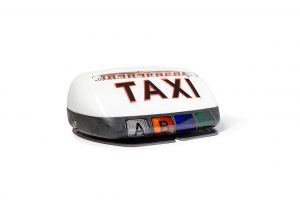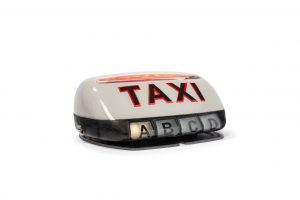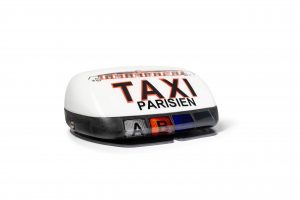You see them on the roof of taxis and that’s what makes them different from other vehicles: taxi lights. But do you know when they are on or off? Starplast, the French taxi lights expert, explains what you need to know in France and in the United Kingdom about this.
Taxi lights in France
The taxi light is the external light that says “TAXI”. The luminous device must be green when it is free, red when it is occupied and off when it is not in activity. It must be connected to the taximeter. You can opt for a fixed or detachable taxi light and add accessories to indicate your town and telephone number.
What do the letters on the roof of the taxi mean?
The letters A, B, C and D correspond to the fare for a taxi ride. The choice of a letter by the taxi driver indicates to the taximeter the price to be charged per kilometre travelled depending on the periode : day, night, on a Sunday or public holiday and the type of transport being undertaken (loaded or unloaded return to the taxi rank).
The letters indicating the different fares in ascending order must be arranged in alphabetical order, from left to right for an observer in front of the taxi. To help distinguish them, each letter has a specific colour:
- A is black on a white background,
- B is black on an orange background,
- C is black on a blue background,
- D is black on a green background.

How does the pricing system work?
Fares vary according to the area, and are therefore different in Paris and the provinces. The kilometre fares are set by the prefecture of the department where the taxi operates. The taximeter must indicate the rate applied in the commune where the taxi is based.
How much is a taxi in France (in the provinces)?
- Fare A: daytime journey to and from the taxi rank,
- Fare B: a night journey to and from the taxi rank, but also on Sundays and public holidays,
- Fare C: daytime journey with return empty at the taxi rank,
- Fare D: night journey with empty return to the taxi rank, including Sundays and public holidays.

How much is a taxi in Paris?
- Fare A: travel in Paris every day between 10am and 5pm, excluding Sundays and public holidays,
- Fare B: a journey made either :
- in Paris every night from 5pm to 10am
- on Sundays from 7am to midnight
- on public holidays at any time,
- in the geographical area of Parisian taxis outside Paris from 7am to 7pm,
- Fare C: journeys made either :
- in Paris from midnight to 7am on Sunday,
- in the geographical area of Parisian taxis outside Paris from 7pm to 7am and on Sundays and public holidays at all hours,
- outside the geographical area of Parisian taxis.
It should be noted that fare D does not exist in Paris.

Taxi lights in the United Kingdom
We have to differentiate taxis vehicles and private hire vehicles (PHV). In the legislation, taxi means hackney carriage. Generally, the customer goes to find a hackney carriage but a private hire car comes to find the customer.
Distinctive characteristics of taxis
Taxis vehicules can be found at various locations in the city and in some of the surrounding towns. A roof sign must be displayed on the top of the vehicle clearly showing the word “Taxi” in black letters on a yellow background (towards the front) and on a red background (towards the rear).
When the roof sign is illuminated, it means that the taxi is available for hire. When the taxi light is off, it means that the taxi is already picking up a customer or is not in operation. You must find another available vehicle.
How are taxis regulated?
Cabs in the UK have two major requirements: the fitting of a taximeter inside the vehicle and a white number plate at the rear of the vehicle. The latter must contain several pieces of information:
- licence number,
- registration number,
- make, model and colour of the vehicle,
- number of passengers it is allowed to carry.
Taxis must also display stickers inside their vehicles giving passengers information about the vehicle and the driver as well as a table of fares in force within the district where the drivers operate.
It should be noted that taxi drivers may not invoice passengers for more than the fare shown on the fare table. However, they may invoice a lower fare. They can also negotiate a different fare if passengers are travelling outside the district before they get into the taxi. Otherwise, drivers invoice as normal.
Is a private hire vehicle a taxi?
Private hire vehicles (sometimes called minicabs) are especially useful if you require a door to door service. They must be pre-booked by telephone or by calling at the office of a private hire operator, they cannot stop in the street and pick you up and they cannot be hailed in the street.
The displaying of signs on or above the roof of a private hire vehicle is permitted but can only consist of the company name, telephone number and must state pre-booking only. The words ‘taxi’, ‘cab’ or ‘Hackney Carriage’ are strictly prohibited. Requests for roof signs on private hire vehicles must be approved by the Licensing Officer.
Taxi lights in London
A black cab is an official taxi in the city of London, which has 23,000 taxis, i.e. 11 taxis per 1,000 inhabitants. Black cabs are most often black but can also carry the colours of an advertising partner. You can take a taxi from one of the many taxi rank located around airports, train stations, underground stations and other busy areas.
When a London taxi light is off, it means that either the taxi is already carrying passengers or the driver is off-duty.
When a London taxi light is on, it means that the taxi is available for hire. So, if you see that the light is on, you can take the taxi. To hail the cab, you just have to stand on the side of the pavement and extend your arm outward. It’s unnecessary to shout “taxi” especially since it’s illegal!
Starplast’s taxi lights in France
Starplast has been specialising in taxi lights for over 20 years. Made in France, we offer two registered models adapted to French regulations: Universal taxi light and Full Led taxi light. Whichever version you choose, they are both available in three fares (A, B and C), approved in Paris, and four fares (A, B, C and D), approved in both Paris and the provinces. They are also compatible with all brands of taximeters and fit all types of vehicles.
